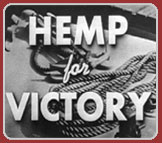 |
|
| Chapter 1: |
Hemp for Victory Part 1
Credit: Department of Agriculture, 1942 |
 |
|
| Chapter 2: |
Hemp for Victory Part 2 |
 |
|
| Chapter 3: |
Hemp for Victory Part 3 |
 |
|
| In order to view the video you need to have RealPlayer installed. |
|
|
By Public WebWorks Staff and wire reports
Industrial hemp is one of the longest and strongest natural fibers in the plant kingdom. It is also
one of the most versatile plants, with approximately 25,000 uses, ranging from paper to textiles to
cosmetics. In addition to being a versatile crop, industrial hemp is also economically viable and
environmentally preferable. Industrial hemp is not a drug. Though it is the same species as
marijuana, it is a completely different variety of plant (similar to comparing a Chihuahua with a St.
Bernard).
Although industrial hemp is experiencing a renaissance in most of the industrialized world
including France, England, Germany and Canada, in the United States, industrial hemp continues
to face a de facto ban on commercial cultivation. So while farmers from across the world grow a
crop that is used to make auto body parts for Mercedes cars or beauty care products for the Body
Shop, farmers facing a farm crisis in the United States are stymied from pursuing a potential
alternative crop.
Although the medieval policies set by the White House Office of National Drug Control Policy
(ONDCP) and the Drug Enforcement Administration (DEA) currently restrict the growing of
industrial hemp in the United States, it wasn't always that way. During World War II, when the
Philippines fell to Japan, the U.S. armed forces needed an alternative fiber supply for its rope,
canvas, and other products. Therefore, the U.S. Department of Agriculture (USDA) ran a "Hemp
for Victory" campaign which aggressively urged farmers to grow the crop. As a result America
grew hundreds of thousands of acres of industrial hemp during the war years. However, once the
war ended, the federal government ceased issuing the licences required to grow the crop.
Today, while American farmers are forbidden from commercially growing this crop, American
manufacturers are allowed to import hemp from China and other nations and to manufacture
hemp products. In the current farm crisis, farmers need alternative crops and hemp will likely be
as or more profitable than other commodity crops. Moreover, the market for industrial hemp is
predicted to increase rapidly. For instance, the use of natural fibers in biocomposites (such as
automobile parts), has been forecasted to grow by 15 -20 percent annually. And, hemp is
expected to be an important commodity for this market due to its favorable strength to weight
ration.
In addition to being a potentially economically viable crop, industrial hemp can also benefit the
environment. Its use in auto biocomposites decreases energy consumption and increases
recyclability compared to glass-filled auto parts. It can replace wood fiber in most applications,
such as building products and paper, aiding forest conservation efforts. It can minimize toxics in
the environment, because when used in pulp for paper, its natural brightness avoids chlorine
bleaching which produces dioxin a powerful environmental toxin. It is also an excellent crop,
that needs few, if any pesticides and herbicides, and used in rotation, it chokes out weeds.
Therefore, crops grown on the same field after hemp have shown increased production yields.
Furthermore, industrial hemp also has a potential to be one of the bio-based fuels which could
replace petroleum as a fuel source, thereby benefitting both national security and the environment.
Unfortunately, the United States will not be able to take advantage of these many benefits anytime
soon due to the backwards American policy that lags behind other industrialized countries.
|